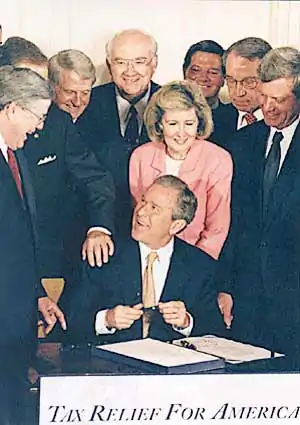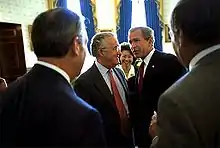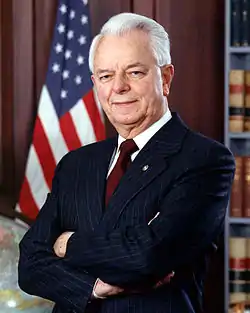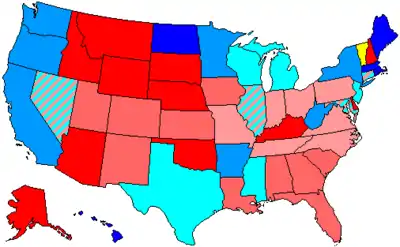107th United States Congress
The 107th United States Congress was a meeting of the legislative branch of the United States federal government, composed of the United States Senate and the United States House of Representatives. It met in Washington, D.C. from January 3, 2001 to January 3, 2003, during the final weeks of the Clinton presidency and the first two years of the George W. Bush presidency. The apportionment of seats in this House of Representatives was based on the 1990 United States Census.
| 107th United States Congress | |
|---|---|
106th ← → 108th | |
 United States Capitol (2002) | |
January 3, 2001 – January 3, 2003 | |
| Members | 100 senators 435 representatives 5 non-voting delegates |
| Senate Majority | Democratic (until January 20, 2001) Republican (Jan 20, 2001 – Jun 6, 2001) Democratic (from June 6, 2001) |
| Senate President | Al Gore (D)[lower-alpha 1] until January 20, 2001 Dick Cheney (R) from January 20, 2001 |
| House Majority | Republican |
| House Speaker | Dennis Hastert (R) |
| Sessions | |
| 1st: January 3, 2001 – December 20, 2001 2nd: January 23, 2002 – November 22, 2002 | |




The House of Representatives had a Republican majority all the way through, while the Senate saw multiple switches - having began with a brief Democratic majority (due to being a 50-50 split and Vice President Al Gore in his constitutional role as Senate President serving as the tie breaker) then switching to Republican (after Dick Cheney became VP on January 20, 2001 and therefore the tie breaker), then back to Democratic (after Senator Jim Jeffords switched from a Republican to an independent who caucused with the Democrats on June 6, 2001, effectively giving the Democrats a 51-49 edge), then late in the term back to the Republicans (due to the death of Democrat Paul Wellstone and special election loss of Democrat Jean Carnahan) - but since the body was out of session by then, formal reorganization was delayed until the next Congress.[1]
Major events
A rare even split in the United States Senate, the defection of a single Senator, and the inauguration of a new vice president, led to three changes in majorities. Major security events occurred. The September 11 attacks were highly disruptive. Some Senators were targeted by anthrax attacks. The Congress voted to allow the President to invade Iraq.
- January 3, 2001: 107th Congress officially begins, with the Senate split 50-50. Democrat Al Gore — the outgoing Vice President — briefly gives the Democrats the tie breaker and majority control.
- January 3, 2001: First Lady Hillary Clinton, wife of President Bill Clinton, became the first presidential spouse to serve in Congress (and briefly holding the titles of both First Lady and Senator).
- January 20, 2001: George W. Bush became President of the United States.
- January 20, 2001: Dick Cheney became Vice President, and the Republicans take control of the Senate with his tie breaking vote.
- May 24, 2001: Senator Jim Jeffords, previously a Republican, declared himself an independent and announced he would join the Democratic caucus, giving the Democrats majority control, effective June 6, 2001.[2]
- September 11, 2001: September 11 attacks
- September 20, 2001: George W. Bush reported to a joint session of Congress on the investigation into the September 11 attacks and announces the War on Terrorism
- October 7, 2001: Operation Enduring Freedom began
- October 9, 2001: Anthrax attacks were executed against members of the Senate, including Senate Majority Leader Tom Daschle.
- December 2001: Corporate financial scandals, including Enron and MCI
- June 12, 2002: Prime Minister of Australia John Howard addressed a joint session of Congress. The address was originally scheduled for September 12, 2001, but was interrupted by the September 11 attacks. Already in Washington at the time, he sat in on Congressional sessions on September 12 instead.
- October 25, 2002: Democratic Senator Paul Wellstone dies in a plane crash, and is replaced by non caucusing independent Dean Barkley for the rest of the term.
- November 23, 2002: Jim Talent takes Senate seat in Missouri, effectively giving Republicans the majority (though formal reorganization was delayed until the convening of the 108th United States Congress).
Major legislation
- June 7, 2001: Economic Growth and Tax Relief Reconciliation Act, Pub.L. 107–16 (text) (pdf), 115 Stat. 38
- October 26, 2001: "USA PATRIOT" Act, Pub.L. 107–56 (text) (pdf), 115 Stat. 272
- January 8, 2002: No Child Left Behind Act, Pub.L. 107–110 (text) (pdf), 115 Stat. 1425
- January 11, 2002: Small Business Liability Relief and Brownfields Revitalization Act, Pub.L. 107–118 (text) (pdf), 115 Stat. 2356
- March 9, 2002: Job Creation and Worker Assistance Act, Pub.L. 107–147 (text) (pdf), 116 Stat. 21
- March 27, 2002: Bipartisan Campaign Reform Act (McCain-Feingold), Pub.L. 107–155 (text) (pdf), 116 Stat. 81
- May 13, 2002: Farm Security and Rural Investment Act of 2002, Pub.L. 107–171 (text) (pdf), 116 Stat. 134
- July 30, 2002: Sarbanes-Oxley Act, Pub.L. 107–204 (text) (pdf), 116 Stat. 745
- August 6, 2002: Trade Act of 2002, Pub.L. 107–210 (text) (pdf), 116 Stat. 933
- October 16, 2002: Authorization for Use of Military Force Against Iraq, Pub.L. 107–243 (text) (pdf), 116 Stat. 1497
- October 21, 2002: Sudan Peace Act, Pub.L. 107–245 (text) (pdf), 116 Stat. 1504
- October 29, 2002: Help America Vote Act, Pub.L. 107–252 (text) (pdf), 116 Stat. 1666
- November 25, 2002: Homeland Security Act, Pub.L. 107–296 (text) (pdf), 116 Stat. 2135
- December 17, 2002: E-Government Act of 2002, Pub.L. 107–347 (text) (pdf), 116 Stat. 2899
Party summary
Senate
| Party (Shading indicates party control) |
Total | ||||||
|---|---|---|---|---|---|---|---|
| Democratic (D) |
Independent (I) |
Independence (IMN) |
Republican (R) |
Vacant | |||
| caucused with Democrats | |||||||
| End of previous Congress |
46 | 0 | 0 | 54 | 100 | 0 | |
| Begin[lower-alpha 2] | 50 | 0 | 0 | 50 | 100 | 0 | |
| January 20, 2001[lower-alpha 3] | 50 | 50 | |||||
| June 6, 2001[lower-alpha 4] | 50 | 1 | 49 | ||||
| October 25, 2002[lower-alpha 5] | 49 | 99 | 1 | ||||
| November 4, 2002[lower-alpha 5] | 1 | 100 | 0 | ||||
| November 23, 2002[lower-alpha 6] | 48 | 1 | 50 | ||||
| November 30, 2002[lower-alpha 7] | 49 | 99 | 1 | ||||
| December 2, 2002[lower-alpha 7] | 50 | 100 | 0 | ||||
| Final voting share | 49% | 1% | 50% | ||||
| Beginning of the next Congress |
48 | 1 | 0 | 51 | 100 | 0 | |
House of Representatives
| Party (Shading indicates majority caucus) |
Total | |||||
|---|---|---|---|---|---|---|
| Democratic | Independent | Republican | Vacant | |||
| caucused with Democrats |
caucused with Republicans | |||||
| End of previous Congress | 208 | 1 | 1 | 222 | 432 | 3 |
| Begin | 211 | 1 | 1 | 221 | 434 | 1 |
| January 31, 2001 | 220 | 433 | 2 | |||
| March 30, 2001 | 210 | 432 | 3 | |||
| May 15, 2001 | 221 | 433 | 2 | |||
| May 28, 2001 | 209 | 432 | 3 | |||
| June 5, 2001 | 210 | 433 | 2 | |||
| June 19, 2001 | 222 | 434 | 1 | |||
| August 5, 2001 | 221 | 433 | 2 | |||
| August 16, 2001 | 220 | 432 | 3 | |||
| September 6, 2001 | 219 | 431 | 4 | |||
| October 16, 2001 | 211 | 220 | 433 | 2 | ||
| November 20, 2001 | 221 | 434 | 1 | |||
| December 18, 2001 | 222 | 435 | 0 | |||
| July 24, 2002 | 210 | 434 | 1 | |||
| August 1, 2002 | 0 | 223 | ||||
| September 9, 2002 | 209 | 433 | 2 | |||
| September 28, 2002 | 208 | 432 | 3 | |||
| November 30, 2002 | 209 | 433 | 2 | |||
| Final voting share | 48.5% | 51.5% | ||||
| Beginning of the next Congress | 205 | 1 | 0 | 229 | 435 | 0 |
Leadership
Senate

(until January 20, 2001)

(from January 20, 2001)


(January 20 – June 6, 2001)
- President: Al Gore (D), until January 20, 2001
- Dick Cheney (R), from January 20, 2001
- President pro tempore: Robert Byrd (D), until January 20, 2001
- Strom Thurmond (R), January 20 – June 6, 2001
- Robert Byrd (D), from June 6, 2001
- President pro tempore emeritus: Strom Thurmond (R), from June 6, 2001
Republican leadership
- Minority Leader: Trent Lott (R), until January 20, 2001, and from June 6, 2001
- Majority leader January 20 – June 6, 2001
- Minority Whip: Don Nickles (R), until January 20, 2001, and from June 6, 2001
- Majority whip January 20 – June 6, 2001
- Republican Conference Chairman: Rick Santorum
- Republican Conference Secretary: Kay Bailey Hutchison
- Republican Campaign Committee Chair: Bill Frist
- Republican Policy Committee Chairman: Larry Craig
Democratic leadership
- Majority Leader: Tom Daschle (D), until January 20, 2001, and from June 6, 2001
- Minority leader January 20 – June 6, 2001
- Majority Whip: Harry Reid (D), until January 20, 2001, and from June 6, 2001
- Minority whip January 20 – June 6, 2001
- Democratic Policy Committee Chairman: Byron Dorgan
- Democratic Conference Secretary: Barbara Mikulski
- Democratic Campaign Committee Chairman: Patty Murray
- Democratic Chief Deputy Whip: John Breaux
Majority (Republican) leadership
- Majority Leader: Dick Armey
- Majority Whip: Tom DeLay
- Chief Deputy Whip: Roy Blunt
- Republican Conference Chairman: J. C. Watts
- Republican Conference Vice-Chairman: Deborah Pryce
- Republican Conference Secretary: Barbara Cubin
- Policy Committee Chairman: Christopher Cox
- Republican Campaign Committee Chairman: Thomas M. Davis
- House Rules Committee Chairman: David Dreier
Minority (Democratic) leadership
- Minority Leader: Dick Gephardt
- Minority Whip: David E. Bonior, until January 15, 2002
- Nancy Pelosi, from January 15, 2002
- Chief Deputy Minority Whips: John Lewis, Ed Pastor, Max Sandlin & Maxine Waters
- Democratic Caucus Chairman: Martin Frost
- Democratic Caucus Vice Chairman: Bob Menendez
- Democratic Campaign Committee Chairman: Nita Lowey
Members
Senate
Senators are listed by their class. In this Congress, Class 2 meant their term ended with this Congress, facing re-election in 2002; Class 3 meant their term began in the previous Congress, facing re-election in 2004; and Class 1 meant their term began in this Congress, facing re-election in 2006.
Alabama
Alaska
Arizona
Arkansas
California
Colorado
Connecticut
Delaware
Florida
Georgia
Hawaii
Idaho
Illinois
Indiana
Iowa
Kansas
Kentucky
Louisiana
Maine
Maryland
Massachusetts
Michigan
Minnesota
Mississippi
Missouri
|
Montana
Nebraska
Nevada
New Hampshire
New Jersey
New Mexico
New York
North Carolina
North Dakota
Ohio
Oklahoma
Oregon
Pennsylvania
Rhode Island
South Carolina
South Dakota
Tennessee
Texas
Utah
Vermont
Virginia
Washington
West Virginia
Wisconsin
Wyoming
|
 Senators' party membership by state
|
House of Representatives
Congressional district numbers are linked to articles describing the district itself.
Changes in membership
Senate
| State (class) |
Vacator | Reason for change | Successor | Date of successor's formal installation[lower-alpha 8] |
|---|---|---|---|---|
| Vermont (1) | Jim Jeffords (R) | Incumbent changed party and joined the Democratic caucus. | Jim Jeffords (I) | June 6, 2001 |
| Minnesota (2) | Paul Wellstone (D) | Incumbent died October 25, 2002. Successor appointed to serve the remaining two months of the term. |
Dean Barkley (IMN) | November 4, 2002 |
| Missouri (1) | Jean Carnahan (D) | Interim appointee lost election to finish the term. | Jim Talent (R) | November 23, 2002 |
| Texas (2) | Phil Gramm (R) | Incumbent resigned November 30, 2002 to give successor seniority advantages. [3][4] | John Cornyn (R) | December 2, 2002 |
| Alaska (3) | Frank Murkowski (R) | Incumbent resigned December 2, 2002 to become Governor of Alaska. Successor appointed to fill the vacancy. |
Lisa Murkowski (R) | December 20, 2002 |
House of Representatives
| District | Vacator | Reason for change | Successor | Date of successor's formal installation[lower-alpha 8] |
|---|---|---|---|---|
| California 32nd | Vacant | Incumbent Julian Dixon (D) had died December 8, 2000, before the beginning of this Congress. A special election was held June 5, 2001. |
Diane Watson (D) | June 5, 2001 |
| Pennsylvania 9th | Bud Shuster (R) | Incumbent resigned, effective January 31, 2001. A special election was held May 15, 2001. |
Bill Shuster (R) | May 15, 2001 |
| Virginia 4th | Norman Sisisky (D) | Incumbent died March 30, 2001. A special election was held June 19, 2001. |
Randy Forbes (R) | June 19, 2001 |
| Massachusetts 9th | Joe Moakley (D) | Incumbent died May 28, 2001. A special election was held October 16, 2001. |
Stephen F. Lynch (D) | October 16, 2001 |
| Arkansas 3rd | Asa Hutchinson (R) | Incumbent resigned August 5, 2001 to head the Drug Enforcement Administration. A special election was held November 20, 2001. |
John Boozman (R) | November 20, 2001 |
| South Carolina 2nd | Floyd Spence (R) | Incumbent died August 16, 2001. A special election was held December 18, 2001. |
Joe Wilson (R) | December 18, 2001 |
| Florida 1st | Joe Scarborough (R) | Incumbent resigned, effective September 6, 2001. A special election was held October 16, 2001. |
Jeff Miller (R) | October 16, 2001 |
| Oklahoma 1st | Steve Largent (R) | Incumbent resigned, effective February 15, 2002, to concentrate on his campaign for governor. A special election was held January 8, 2002. |
John A. Sullivan (R) | February 15, 2002 |
| Ohio 17th | Jim Traficant (D) | Incumbent expelled July 24, 2002 for criminal conviction of 10 counts of bribery, racketeering, and tax evasion. | Vacant | Not filled for remainder of Congress |
| Virginia 5th | Virgil Goode (I) | Incumbent changed party. | Virgil Goode (R) | August 1, 2002 |
| Ohio 3rd | Tony P. Hall (D) | Incumbent resigned September 9, 2002 after he was appointed to be the U.S. Ambassador to the United Nations Food and Agriculture Organization. | Vacant | Not filled for remainder of Congress |
| Hawaii 2nd | Patsy Mink (D) | Incumbent died September 28, 2002 but was elected posthumously on November 5, 2002. | Ed Case (D) | November 30, 2002 |
Committees
Lists of committees and their party leaders, for members (House and Senate) of the committees and their assignments, go into the Official Congressional Directory at the bottom of the article and click on the link (1 link), in the directory after the pages of terms of service, you will see the committees of the Senate, House (Standing with Subcommittees, Select and Special) and Joint and after the committee pages, you will see the House/Senate committee assignments in the directory, on the committees section of the House and Senate in the Official Congressional Directory, the committee's members on the first row on the left side shows the chairman of the committee and on the right side shows the ranking member of the committee.
Senate
|
House of Representatives
|
Joint committees
- Economic (Chair: Rep. Jim Saxton, Vice Chair: Sen. Jack Reed)
- Taxation (Chair: Rep. Bill Thomas, Vice Chair: Sen. Max Baucus)
- The Library (Chair: Rep. Vernon J. Ehlers, Vice Chair: Sen. Chris Dodd)
- Printing (Chair: Sen. Mark Dayton, Vice Chair: Rep. Robert W. Ney)
Caucuses
Employees
Legislative branch agency directors
- Architect of the Capitol: Alan M. Hantman
- Attending Physician of the United States Congress: John F. Eisold
- Comptroller General of the United States: David M. Walker
- Director of the Congressional Budget Office: Dan Crippen
- Librarian of Congress: James H. Billington
- Public Printer of the United States: Michael F. DiMario, until 2002
- Bruce James, from 2002
Senate
- Chaplain: Lloyd John Ogilvie (Presbyterian)
- Curator: Diane K. Skvarla
- Historian: Richard A. Baker
- Parliamentarian: Bob Dove, until May 2001
- Alan Frumin, May 2001 - end
- Secretary: Gary Lee Sisco, until July 11, 2001
- Jeri Thomson, July 12, 2001 - end
- Librarian: Greg Harness
- Sergeant at Arms: James W. Ziglar, until August 2, 2001
- Alfonso E. Lenhardt, September 4, 2001 - end
- Secretary for the Majority / Minority:
- Martin P. Paone (Democrats)
- Elizabeth B. Letchworth (Republicans)
- David J. Schiappa (Republicans)
House of Representatives
- Chaplain: Daniel P. Coughlin (Roman Catholic)
- Chief Administrative Officer: James M. Eagen III
- Clerk: Jeff Trandahl
- Parliamentarian: Charles W. Johnson
- Reading Clerks:
- Mary Kevin Niland (D)
- Paul Hays (R)
- Sergeant at Arms: Wilson Livingood
- Inspector General: Steven McNamara
See also
- 2000 United States elections (elections leading to this Congress)
- 2002 United States elections (elections during this Congress, leading to the next Congress)
Notes
- U.S. Vice President Al Gore's term as President of the Senate ended at noon on January 20, 2001, when Dick Cheney's term began.
- Al Gore (D) was U.S. Vice President until January 20, 2001 with the tie-breaking vote.
- Dick Cheney (R) became U.S. Vice President January 20, 2001 with the tie-breaking vote.
- In Vermont, James Jeffords switched June 6, 2001 from Republican to Independent and caucused with Democrats.
- In Minnesota, Paul Wellstone (D) died October 25, 2002. Dean Barkley (IMN), who didn't caucus with either party, was appointed November 4, 2002 to Wellstone's seat.
- In the November 5, 2002 Missouri special election, Jim Talent (R) took Jean Carnahan (D)'s seat and became senator November 23, 2002, but there was no reorganization because Senate was out of session.[1]
- In Texas, Phil Gramm (R) resigned November 30, 2002 to give his successor advantageous office space. Senator-elect John Cornyn (R) was appointed December 2, 2002 to finish Gramm's term.
- When seated or oath administered, not necessarily when service began.
References
- "Party Division in the Senate, 1789-Present" – via Senate.gov.
- "Leaving Republican Party: Jeffords' 2001 speech". Burlington Free Press. August 18, 2014. Retrieved January 10, 2019.
- Associated Press (November 21, 2002). "Cornyn Gets Early Start in Senate". The Edwardsville Intelligencer. Retrieved November 3, 2020.
- "SENATORS OF THE UNITED STATES > 1789-present > A chronological list of senators since the First Congress in 1789" (PDF). United States Senate – via Senate.gov.
![]() This article incorporates public domain material from the Biographical Directory of the United States Congress website http://bioguide.congress.gov.
This article incorporates public domain material from the Biographical Directory of the United States Congress website http://bioguide.congress.gov.
External links
- United States 107th Congress Web Archive from the U.S. Library of Congress
- Congress.gov
- History, Art and Archives from the United States House of Representatives
- Statistics & Lists from the United States Senate
- Booknotes interview with Tom Daschle on Like No Other Time: The 107th Congress and the Two Years That Changed America, November 30, 2003.
- "Videos of House of Representatives Sessions for the 107th Congress from www.C-SPAN.org".
- "Videos of Senate Sessions for the 107th Congress from www.C-SPAN.org".
- "Videos of Committees from the House and Senate for the 107th Congress from www.C-SPAN.org".
- House of Representatives Session Calendar for the 107th Congress (PDF).
- Senate Session Calendar for the 107th Congress (PDF).
- Congressional Pictorial Directory for the 107th Congress.
- Congressional Pictorial Directory for the 107th Congress (Revised).
- Official Congressional Directory for the 107th Congress.
- Official Congressional Directory for the 107th Congress (Revised) (PDF).




.svg.png.webp)

.svg.png.webp)

